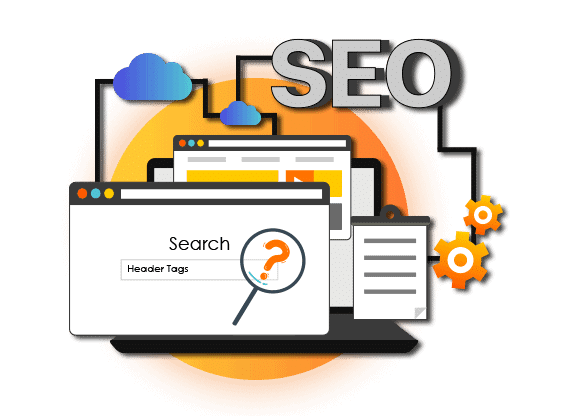
Headings as a general rule, search engine optimization is thought to be better when there are headers. H1 tags, H2 tags, or even H3 tags can be used in different situations. On the other hand, do they have a big impact on where you show up in search results?
It is true that many content management systems (CMS) include headers by default in the pages you make for your site. This is how they write their page title (or blog post title) and, sometimes, parts of a page.
Why do things matter? Is it whether or not they help with search engine rankings?
The expert came up with a fun way to see if these things are actually good for you.
An SEO Headings Study Case
People on our email list were asked to take part in the experiment, just like in previous tests. We did the same thing with the links we put in my blog comments and with link-building.
4,104 of you have said that you’re interested in the subject. We only did this test on websites that get at least 100,000 organic search traffic a month.

We chose bigger places so that we could better keep track of traffic changes. There may be more of an effect from outside factors on statistics for sites that get less than 100 views a month. Simple public relations efforts in this case could triple the number of people who come to see the show.
Sites that were only open for a few months of the year were also removed. We have just tried to make the results less skewed again, but this time we didn’t work as hard.
In terms of organic traffic, younger sites tend to gain faster than older ones, even though they spend less time and money on SEO because their users are smaller.
Finally
61 sites met our needs. The average number of pages on each website is 426, but this can vary.
It’s important to divide your visitors into two groups when you do an A/B test. One group sees one version, and the other group sees the other. To see if it worked, you need to make a change and then compare the results to the last 30 days. This is why we did a lot of tests on each site to see how headers affected how well it did. Each site’s pages were broken down into four groups:
Pages that haven’t been changed in any way. We wanted to see how their organic traffic changed over time, no matter if they used headers or not. This is how the page title was made: H1 tags were used. H2 tags were used to make subsections of the page, and even H3 and H4 tags if the subsections had sub-subs.
We checked each page in this category to see if there were plain text headers on them. We also made sure that all of the typefaces were the same size, and we did that too. Standard p> content with different font sizes; headers aren’t needed in this part of the text. Instead, we made sure that the material was available in a wide range of typefaces, not just one or two types of fonts. The title of the page, for example, was shown in the largest font possible.
All in all, the trial took place over the course of 90 days. We used data from 30 days before and after the change to compare the results of the pages we made changes to.
Control
A group called “control” is what we’re referring to in this case. The traffic in the control group went up 2.89 percent more than in the experimental group. The control group’s pages had headers on some of them, but they didn’t have headers on others.
Visitors and search engines both benefit from bigger font sizes on a website because they show which parts of a page and which individual keywords are more important. And those characteristics really match the nature of the H1 and H2. To conclude, we cannot neglect the importance of the headings roles in SEO.
How to use Header Tags for SEO Best Practices
Header tags are important to both Google and your users. Some ideas to help you make your own. For search engines, header tags are still a big deal. Google’s John Mueller said the following:
As part of search engine optimization, header tags are a big part (of SEO). When keywords are used correctly, both users and search engine gods are happy.
Header Tag Defined
A “header tag” is a piece of HTML that tells a browser how to arrange the content on your site. The header is made up of HTML code that looks something like this:
<h2>What is a Header Tag?</h2>
Tags, like print headers, are used to show and explain the information below them. These tags are called H1 through H6, and they are used a lot in HTML, too.
These tags are called H1 and are used to show important information, like the main subject of a piece of text or its title.
Subheadings (H2 and H3) are used a lot.
These sections could also be grouped together with H4-H6 tags.
Tags that are easy for people and search engines to use. Users can click on one of them to see what they’re about to read.
They help search engines, like Google, understand the context and order of the results that they show. It’s possible to think of chapter names as header tags. Quick reading will help you figure out what’s going on. This helps Google better understand your content because they make it easier to read and understand. Header tags also make your content easier to read and understand.
Structure the content using the best header tags
Your article will be improved as a result. The headlines should inform the reader about the content of the following paragraphs. Consider header tags to be the table of contents of a nonfiction book:
- What does your H1 say about the topic of your article?
- H2s, which are similar to book chapters, summarize key ideas.
- The H3-H6 headers function as subheadings inside each section, much like the subtopics in a book chapter.
Before you start creating a blog post or a landing page, consider what you want your readers to take away from it. Tags to use in your headers. Make an outline for your essay using these.

Make article easier to scan with sub-headings
There are a lot of things you can do with scannable articles and articles that are more likely to show up high in search engine results. This is because Google likes content that is easy for people to read. Easy-to-read information is more user-friendly than hard-to-understand information. Because it can be scanned, people are more likely to read an item before going to Google. They are also more likely to share it with their friends, which is good.
The more backlinks an article gets, the better it will rank in search engine results, even if social signals alone aren’t enough. This is true even if an article submission is frequently shared on social networking sites.
Include keywords in header tags
Header tags are used by Google to learn about your website’s surroundings, say experts.
In order to get Google to notice you, you need to put keywords in your head tags. The fact that this is true doesn’t mean that you should overdo it with keyword stuffing. Instead of being a spammer, be picky about what you say.
To understand this post, look at the header tags and you’ll see that many of them have keywords. It even shows up in the H2 of this section! “Header tags,” on the other hand, is not the word we are talking about. We’ve put it in a lot of the H2s to show how important it is to this post. Because this type of repetition may bother people, we haven’t used it in every single H2.
To start, your page should be easy to find. This is a good idea if your content naturally includes words that are linked with them. You may want to add them. Always think about the people who will use the software when you make it. This will then be ready to be found by search engines like Google.
Leveraging the featured snippets
If you search for something on Google, snippets that are “featured” show up right at the top of the page in position 0.
They are quick to answer users’ questions. When a search is relevant, featured snippets are more likely to show up. The organic search results on Google are shown above a list, table, text with a picture or video, and sometimes even a video. Featured websites may get more traffic and clicks because the featured snippet box is now bigger.
A good way to start is to put your goal keyword or phrase into the page’s text. If you can, use an H2 header tag to ask the keyword phrase as a question if it’s possible to do so. Build a basic sentence structure in a text fragment by using one or two phrases that are the best fit for the text. With a question, build your answer with important words and bullet points. Google only shows a small number of bullet points to make your site more likely to be clicked on.
Many rows and the keyword phrase at the head of a table are good ways to organize and group your information. As a result, when you optimize your content this way, Google no longer shows the whole table.
Then, after you’ve made your website’s content more search-friendly, you can see how it’s doing with Google Search Console or our Search metrics Suite tool. In the Search Console, you can see how many people click on your site, how many people click on your site, and more for each ranking position, even Position 0.
Check H1 on every page of your blog or website
To clear up one of the most common myths about SEO, let’s talk about it. Because Google doesn’t think there’s a problem with a lot of H1 tags, I don’t have to worry about it. If you use a lot of H1 tags on a single page, that doesn’t mean it’s a good idea to do that for SEO.
Try something new. There’s no harm in that. The way they are written makes them look like titles to people, so they think of them that way. Things may look bad when a lot of H1s are all on the same page. You should make sure that your website doesn’t have any H1 tags that aren’t your own.
Crawlers
Like Screaming Frog, can be used to look at your site.
To see if any of your pages don’t have any H1s or have too many H1s, switch to the H1 tab.
After that, use the Filter drop-down box to choose and save only the photos that need work.If you search for something on Google, snippets that are “featured” show up right at the top of the page in position 0.
They are quick to answer users’ questions. When a search is relevant, featured snippets are more likely to show up. The organic search results on Google are shown above a list, table, text with a picture or video, and sometimes even a video. Featured websites may get more traffic and clicks because the featured snippet box is now bigger.
In the first place, it will raise your website’s rank in Google search results. Most of the organic results have been moved to the bottom. Only sponsored ads show up above 0. Many people think that customers don’t need to go to the website because the snippet will give them the answer. Readers must click on the link and go to the landing page, where they can see the full text, list, or table. As a result of this SERP feature, SEO and content marketing can be used to boost organic traffic to your site.
Tweak your header tags
When someone views a website, it is the first thing that springs to mind. Yes, the title is appropriate for the search query. When he’s finished, he clicks the link to proceed. Then, match your header tag to the user’s search so that visitors may reach your site. What exactly are “header tags”? The header of a page is determined by how heading tags are utilized. They can be used in HTML. These are the elements that contribute to a successful SEO strategy. Use the H1, H2, H3, H4, and H6 categories while writing to improve your score. The first heading is H1, while the sixth is H6.
Headers assist Google in determining the topic of a page. It is critical to include your keywords in the header tags since they are a valuable source of information.
Contrary to popular belief, employing a large number of H1s on a website does not harm its SEO. When people see several H1, they may become confused because they believe it is the primary title.
People may dislike some of the names on the page’s initial material, but they must come up with new ones to find the ideal one. This rule applies to all headers, but H1 is particularly significant.
Verdict
Despite the fact that header tags aren’t directly related to search engine rankings, they do have an influence. As a result, it is critical that you pay attention to every detail and design headlines that are appealing to your target audience.